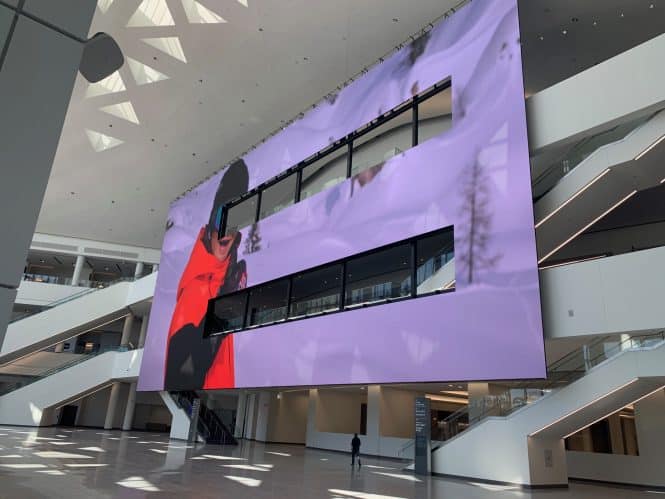Interactive Digital Signage Wayfinding
Most of our members specialize in interactive digital solutions. If you are looking for provider companies, then this is a good place to start. For content display only, there are 100s of companies, usually free, which want to do that.
Interactive displays account for a significant and growing portion of the digital signage market in 2025, but they still make up a minority overall. Industry estimates indicate that interactive screens—including touchscreens, gesture-controlled, and kiosk-type digital signage—represent about 18% to 22% of the digital signage market globally. Interactive displays are particularly prominent in retail, education, and transportation, where customer or visitor engagement is a top priority. Menu boards via voice for outdoor add at least another 20%.
We recommend commercial quality displays and touchscreens. Displays are cheaper from Amazon and Best Buy, but only in the short run. Remote monitoring and redundant internet are good to have.
Categories
- Pure digital signage — which is your typical advertising media-presentation only (DOOH eg)
- Interactive digital with touch — large wayfinding kiosks, ai assist, smart city, EV charging
- Interactive digital via voice — menu boards display info, but you transact via microphone
- Media players range from USB stick, Raspberry Pi, to inexpensive Celeron to better i5 to TOPS-rated for AI assist.
Digital Signage Companies
- Nanonation – custom kiosk software & digital signage (interactive and dynamic)
- 22 Miles – Interactive and Dynamic Digital Signage and Wayfinding
- LG Electronics Business Solutions
- Acquire Digital – advanced digital signage and wayfinding technology software
- Giada — for media players and miniPCs
- Goldfinger Monitors – Digital Signage
- SiteKiosk – SiteCaster interactive digital signage CMS software with remote monitoring
- meldCX — provides metrics and analytics —Digital Signage Vision Analytics – meldCX and ASUS
- Insight Touch touchscreens. 10″ to 65″ PCAP. Customized.
- BoldVu BoldVu® displays are built not simply to survive, but to thrive in outdoor environments.
- TDS TOUCH – touchscreens of all technologies
- Actineon – for media players
- More: Peerless-AV and Keyser
Digital Menu Boards
- LG Electronics Business Solutions
- Insight Touch touchscreens. 10″ to 65″ PCAP. Customized.
- BoldVu – BoldVu® displays are built not simply to survive, but to thrive in outdoor environments.
- We also recommend Keyser in Chicago and Peerless-AV
For more on digital signage companies
We often post digital signage RFPs that we see. The Digital Signage and Smart City update page is where you can find those.
Digital Signage Background
A digital signage kiosk is a device that displays digital content, such as texts, images, videos, and interactive features, to attract and engage customers or visitors. It usually consists of a touchscreen display, a software application, and a media player. Some also have a payment function, such as a card reader or a QR code scanner. These are used in various industries and settings, such as retail, hospitality, food and beverage, healthcare, education, and entertainment12.
There are many benefits, such as:
- Enhancing customer experience and satisfaction by providing personalized and relevant information, entertainment, and services.
- Increasing sales and revenue by promoting products, services, and offers, and enabling faster and easier transactions.
- Reducing operational costs and improving efficiency by automating tasks, saving space, and minimizing errors and waste.
- Collecting data and feedback from customers and visitors, and analyzing their behavior and preferences.
- Improving brand awareness and loyalty by creating a distinctive and memorable impression.
Some examples of solutions are:
- Samsung Kiosk: A flexible, all-in-one kiosk solution that operates on Windows 10 IoT Enterprise or Tizen operating systems, and integrates with various software providers. It is suitable for any high-traffic self-service environment, such as convenience stores, live events, sports, and hospitality2.
- KIOSK Digital Smart Signage: A smart digital signage solution that leverages AI and data to personalize content and deliver interactive features. It is designed for various market applications, such as retail, food and beverage, healthcare, and education1.
- FASTSIGNS Digital Kiosks: A range of digital kiosk options that can be customized to fit any space and purpose. They can display dynamic content, such as menus, directories, maps, and social media feeds3.
If you want to learn more about digital signage kiosks, you can check out the following links:
- Digital Smart Signage Kiosk Solutions | Touch Screen Kiosk | KIOSK
- Samsung Kiosk | Interactive Displays | Samsung Business | US
- What Is a Digital Signage Kiosk?
- Digital Signage Kiosks: Interactive Features, Benefits & Solutions
- Touch Screen Kiosks | Digital Interactive Displays – FASTSIGNS
Digital Signage Market Research 2024
According to various sources, the digital signage market size is estimated to be between USD 25.52 billion and USD 42.54 billion in 2024, and is expected to grow at a CAGR of 7.7% to 8.4% from 2024 to 203012345. The market is driven by factors such as the increasing demand for enhanced customer experience, the rising adoption of innovative display technologies, and the growing use of digital signage in various industries and settings12345. However, the market also faces some challenges, such as the high initial investment and maintenance costs, the regulatory and environmental issues, and the competition from online advertising and other media channels12345.
Key Statistics For Interactive
-
Interactive digital signage has shown a compound annual growth rate (CAGR) of more than 17% through 2025, making it one of the fastest-growing segments within the industry.
-
The global interactive display market is valued higher than the pure digital signage segment because it includes educational whiteboards, kiosks, and other applications, with kiosks accounting for a notable share.
-
The adoption rate for interactive solutions in places like retail and hospitality is climbing, but non-interactive/static signage continues to dominate much of the market, especially in cost-sensitive public and outdoor applications.
In summary, about 1 in 5 digital signage displays worldwide are interactive as of 2025, a percentage that is projected to continue rising in coming years.
